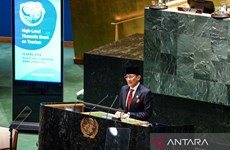ASEAN works hard to build economic community
ASEAN leaders took note of and expressed satisfaction at the
progress towards setting up an ASEAN Economic Community (AEC) by the end
of 2015.
ASEAN leaders took note of and expressed satisfaction at the
progress towards setting up an ASEAN Economic Community (AEC) by the end
of 2015.
However, ASEAN member countries need to make greater efforts to realise the goal, according to the Chairman's statement at the 22nd ASEAN Summit, which took place in Bandar Seri Begawan, Brunei from April 24-25.
The statement said 77.57 percent of the AEC Blueprint has been implemented so far.
The leaders agreed to enhance ASEAN's competitiveness by better facilitating trade and investment, leveraging upon on-going work to establish the AEC.
They also recommended rolling out a roadmap to set out initiatives that will simplify the way of doing business and address investment impediments in the region.
Filipino Trade Secretary Gregory Domingo said ASEAN has already achieved about three quarters of its targets relating to its single-market goal since it began the process in 2007.
But he also said many challenges are ahead, including a framework to open up the services sector, which includes banking, insurance, telecommunications and retail, within ASEAN.
On trade, Domingo said agriculture is among the most difficult sectors to fully liberalise.
Official statistics show that since the adoption of the Blueprint in November 2007, per capita income in the region has risen from 2,267 USD to 3,759 USD in 2012.
Total trade in the 10-nation bloc grew by 16.8 percent, from 2.05 trillion USD in 2010 to 2.4 trillion USD in 2011. Intra-ASEAN trade reached 598 billion USD from 520 billion USD in the same period, a year-on-year increase of 15.1 percent.
The ASEAN region has also continued to attract foreign investors, generating a record level of foreign direct investment of 114 billion USD in 2011, a 23 percent rise from 2010.
Established in 1967, the ASEAN members are Brunei, Cambodia, Indonesia, Laos, Malaysia, Myanmar, the Philippines, Singapore, Thailand and Vietnam. The bloc’s total population is 600 million.-VNA
However, ASEAN member countries need to make greater efforts to realise the goal, according to the Chairman's statement at the 22nd ASEAN Summit, which took place in Bandar Seri Begawan, Brunei from April 24-25.
The statement said 77.57 percent of the AEC Blueprint has been implemented so far.
The leaders agreed to enhance ASEAN's competitiveness by better facilitating trade and investment, leveraging upon on-going work to establish the AEC.
They also recommended rolling out a roadmap to set out initiatives that will simplify the way of doing business and address investment impediments in the region.
Filipino Trade Secretary Gregory Domingo said ASEAN has already achieved about three quarters of its targets relating to its single-market goal since it began the process in 2007.
But he also said many challenges are ahead, including a framework to open up the services sector, which includes banking, insurance, telecommunications and retail, within ASEAN.
On trade, Domingo said agriculture is among the most difficult sectors to fully liberalise.
Official statistics show that since the adoption of the Blueprint in November 2007, per capita income in the region has risen from 2,267 USD to 3,759 USD in 2012.
Total trade in the 10-nation bloc grew by 16.8 percent, from 2.05 trillion USD in 2010 to 2.4 trillion USD in 2011. Intra-ASEAN trade reached 598 billion USD from 520 billion USD in the same period, a year-on-year increase of 15.1 percent.
The ASEAN region has also continued to attract foreign investors, generating a record level of foreign direct investment of 114 billion USD in 2011, a 23 percent rise from 2010.
Established in 1967, the ASEAN members are Brunei, Cambodia, Indonesia, Laos, Malaysia, Myanmar, the Philippines, Singapore, Thailand and Vietnam. The bloc’s total population is 600 million.-VNA












